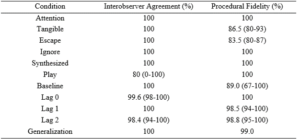Functional Communication Training with Lag Schedules of Reinforcement to Increase Variable Mands
Authors: Kelly C. Willard, Erin E. Barton, Mollie J. Todt, and Elizabeth A. Pokorski![]()
Summary:
Children with disabilities are more likely to engage in challenging behavior (CB) than their typically developing peers. Patterns of CB during early childhood are associated with poor outcomes, including academic failure and social maladjustment (Dunlap et al., 2006; Plant & Sanders, 2005; Powell et al., 2006). Functional communication training (FCT) is an evidence-based practice, often used with this population to teach a specific, socially appropriate response (i.e., mand) to meet and replace the identified function of the CB. However, FCT only trains a single response, which may promote rote responding, fail to generalize across settings, and cause a resurgence of CB when the trained mand contacts extinction. Therefore, it may be useful to train multiple responses during FCT. A lag schedule of reinforcement, which has effectively been used to promote variable responding of vocal and non-vocal responses, may be effective when training multiple mand modalities to increase variable responding (Lee et al., 2002; Silbaugh & Falcomata, 2017; Silbaugh et al., 2017). Preliminary research with older children indicated a functional relation between FCT with a lag schedule and mand variability, while CB remained low (Adami et al., 2017; Falcomata et al., 2018). Porkorski (2019) extended findings to three preschoolers with Autism Spectrum Disorder (ASD).
In the current study, we used an A-B-A-B reversal design to examine the relation between FCT with a lag schedule of reinforcement and frequency and variability of mands and challenging behavior with a preschooler with Down syndrome. The participant was a five-year-old female. We found a functional relation between FCT with a lag schedule of reinforcement and frequency and variability of mands and challenging behavior, although patterns of responding were distinct. We also tested the generalization of her responding to the playground at her school and results were promising. Masked raters indicated that the intervention was socially valid and could be used across contexts, children, and behaviors. Our single case study met contemporary design standards for IOA and procedural fidelity.
Interobserver Agreement (IOA) and Procedural Fidelity (PF):
Table 1. Interobserver Agreement and Procedural Fidelity by Condition (Range)
